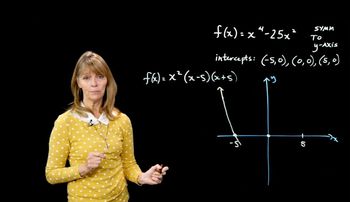Table of contents
- 0. Review of Algebra4h 16m
- 1. Equations & Inequalities3h 18m
- 2. Graphs of Equations43m
- 3. Functions2h 17m
- 4. Polynomial Functions1h 44m
- 5. Rational Functions1h 23m
- 6. Exponential & Logarithmic Functions2h 28m
- 7. Systems of Equations & Matrices4h 6m
- 8. Conic Sections2h 23m
- 9. Sequences, Series, & Induction1h 19m
- 10. Combinatorics & Probability1h 45m
4. Polynomial Functions
Dividing Polynomials
Problem 37
Textbook Question
In Exercises 33–40, use synthetic division and the Remainder Theorem to find the indicated function value. f(x)=x^4+5x^3+5x^2−5x−6;f(3)
 Verified step by step guidance
Verified step by step guidance1
Identify the polynomial function \( f(x) = x^4 + 5x^3 + 5x^2 - 5x - 6 \) and the value \( x = 3 \) for which we need to find \( f(3) \).
Set up synthetic division by writing the coefficients of the polynomial: \( 1, 5, 5, -5, -6 \).
Write the value \( 3 \) to the left of the coefficients, as this is the value for which we are evaluating the function.
Bring down the leading coefficient (1) to the bottom row.
Multiply the value brought down (1) by \( 3 \) and write the result under the next coefficient (5). Add this result to the coefficient and continue this process across all coefficients.
Recommended similar problem, with video answer:
 Verified Solution
Verified SolutionThis video solution was recommended by our tutors as helpful for the problem above
Video duration:
4mPlay a video:
Was this helpful?
Key Concepts
Here are the essential concepts you must grasp in order to answer the question correctly.
Synthetic Division
Synthetic division is a simplified method for dividing a polynomial by a linear binomial of the form (x - c). It involves using the coefficients of the polynomial and performing a series of multiplications and additions to find the quotient and remainder. This technique is particularly useful for evaluating polynomials at specific values, as it reduces the computational complexity compared to long division.
Recommended video:

Higher Powers of i
Remainder Theorem
The Remainder Theorem states that when a polynomial f(x) is divided by a linear factor (x - c), the remainder of this division is equal to f(c). This theorem allows us to evaluate the polynomial at a specific point without fully performing the division, making it a powerful tool for quickly finding function values and understanding polynomial behavior.
Recommended video:

Higher Powers of i
Polynomial Functions
A polynomial function is a mathematical expression involving a sum of powers in one or more variables multiplied by coefficients. In this case, f(x) = x^4 + 5x^3 + 5x^2 - 5x - 6 is a fourth-degree polynomial. Understanding the structure of polynomial functions, including their degree, leading coefficient, and behavior at various points, is essential for applying synthetic division and the Remainder Theorem effectively.
Recommended video:

Introduction to Polynomial Functions
Related Videos
Related Practice

